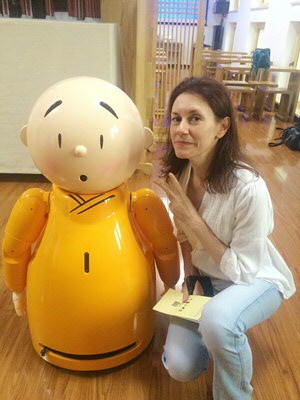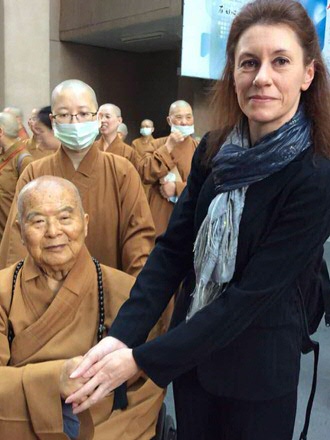Praying in modern China

China's influence on the Western world is growing in many respects. But how much do we really know about this immense country? According to Stefania Travagnin, if you want to understand modern China, you should look through the lens of religion. Alumnus Remko Tanis, who spent six years in Shanghai as a China correspondent and lived in Singapore until very recently, spoke to her.
The Buddhist temple of Jing’an (Peace and Tranquillity) has stood in the same place in Shanghai for 800 years. In the 13th century, the area was certainly peaceful and tranquil, but these days the temple is surrounded on all sides by 21st-century China. Literally all sides: every day at least a million people pass through the metro station built underneath it. At street level, the temple is confined by shops and restaurants. Skyscrapers housing offices and luxury hotels tower above it. It looks anything but religious. This is probably logical in a country that has spent seventy years under fervent atheist Communist rule. And yet according to Stefania Travagnin, you still need to look through the lens of religion to understand modern China. ‘In China, the secular and religious worlds have always been closely intertwined’, she explains. She’s on a flying visit to Groningen, squeezed in between two trips to Taiwan. ‘China is a huge, diverse country with at least fifty ethnic groups and countless religious movements. It has an incredibly complex history, which obviously implies that the present is complex too. It would be impossible to understand this country without considering the culture and therefore its religions.’

Talking to a robo-monk
But first: ‘Religion is a western term,’ says Travagnin. ‘The term didn't mean anything in Chinese until the advent of Christianity. Buddhist monks sometimes wondered whether they adhered to a religion, a science or a philosophy. Or to all of them. Or perhaps none of them.’ It all merges into one. As do many of the diverse religious movements in China. ‘In the West, you’re either Christian, or you're Muslim or you're Jewish. The one automatically excludes the other. This is very different in China. A Chinese person can pray in a Buddhist temple one day and in a Taoistic one the next. If there happens to be a Confucian temple close-by, that's where you go. Or you say your prayers online using the temple’s app. A lot of temples have a QR code. You scan it with your phone to talk to a monk, real or robot. It doesn’t matter how or where you do do it, as long as you pray as often as possible.’ The seamless transitions between the different religious movements and methods are what fascinate Travagnin. ‘It’s a good lesson for the West, where the boundaries between religions are very black-and-white. And if you pray in lots of different temples, one of them is bound to be the right one!’
Marco Polo
Travagnin grew up in Venice. ‘Being an Italian, I was raised a Catholic but my parents gave me the freedom to explore other options. They weren’t particularly bothered when I stopped going to church.’ Various factors throughout her youth nudged her in the direction of the East. ‘I come from Venice and I'm a huge fan of Marco Polo. Venice is Marco Polo, so that was part of it.’ At the age of six, she spent half-an-hour a day watching Japanese cartoons on television. ‘I still remember all the songs. I went to my mother in the kitchen and said I wanted to eat rice. But pasta won.’ As a child, she didn’t go swimming or to ballet classes like other children. Instead, Travagnin chose the only karate school in the city. ‘Secondary school was great, but you mainly learned about the West and a little bit about the colonies in Africa. The opium wars in China were the only thing we heard about Asia.’ So she decided to take a degree programme in Sinology at Ca’Foscari University of Venice. ‘I wanted to challenge everything I knew about the West, put it to the test using new knowledge about the East. A programme in Chinese language and history takes you right to the heart of the region.’
Atheism
Back to Shanghai. The scent of ritually burning incense stubbornly dominates the commercial avalanche threatening to bury the Jing’an temple. The temple is packed every day from morning to evening. Han Buddhism is alive and well, contrary to what one hears from Beijing. The Communist Party will never acknowledge that its authority is linked to anything remotely approaching ‘The Mandate of Heaven from the Empire’. In November, Chen Xi, leader of the Organization Department of the Party, said that it was dangerous to believe in ‘spirits and gods’ rather than Marx and Lenin, proving that atheism is still the basic principle. According to Chen, the only faith that counts is solid confidence in Xi Jinping as the mainstay of the Party. Fascinating, says Travagnin. ‘Xi is using religious dynamics to create a cult around himself. It’s exactly what Mao did.’

Moral vacuum
But unlike Mao, Xi does not see religion (or at least Han Buddhism) as a threat, but as a handy instrument. ‘China is stuck in a moral vacuum,’ says Travagnin. ‘New generations have lost sight of the old Confucian values. Showing respect to the elderly, helping each other, society as a harmonious entity: everything that used to work has disappeared. People are confused, they’re looking for an identity. Mao’s Cultural Revolution stripped back the old values, destroyed them. But society cannot operate without values. The Party is now trying to reverse the situation by promoting the principles of Confucius, which are in the DNA of Chinese civilization.’ Han Buddhism fits in perfectly with Confucianism, and is different from ‘original’ Buddhism from India. ‘In English, they call it humanist Buddhism. This doesn’t make much sense, but it basically means that it’s a very practical form of the original. It focuses more on the values that help in one’s dealings with other people and are good for society, than on higher realms and life after death.’ The Party also uses Han Buddhism to promote nationalism. ‘They can do this because every temple is affiliated to a coordinating organization that aligns policy with that of the Party. You see the same four Chinese characters on every temple: ai guo, ai jiao. Love your country, love your religion. Anyone calling him/herself a Han Buddhist must respect these four characters.’
Online rituals
Travagnin is currently working on a three-year research project in the province of Sichuan, a region in which Islam, Protestantism, Catholicism, Buddhism and Taoism all cross paths. She is heading the research team together with Elena Valussi from Loyola University in Chicago. ‘We want to work out how the various religious networks influence each other, not from the point of view of the institutes or leaders, but bottom-up, through the eyes of the population.’ It continues on from research she conducted into the use of modern media by religious movements in China. ‘The apps and websites that temples use to attract and involve young people are jeopardizing the sense of community. People don’t come together any more. This is probably why the government is so keen to promote these online rituals. The more people praying to their own screens, the fewer gatherings they have to monitor.’
Stefania Travagnin (1975) is a Rosalind Franklin Fellow, and has been an Assistant Professor in Religion in Asia, and founder and director of the Centre for the Study of Religion and Culture in Asia in the Faculty of Theology and Religious Studies at the UG since 2013. She is also a visiting professor to the Faculty of Missiology at Pontificia Università Urbaniana in Vatican City. Travagnin was previously Assistant Professor at the universities of Missouri (USA), Saskatchewan (Canada), Pennsylvania (USA) and Manchester (UK). She was awarded a PhD by the University of London in 2009. In 2000 in her home city of Venice, she graduated ‘summa cum laude’ with a Major in Chinese language, religion and philosophy and a Minor in Hindi and Indian religions and philosophy. As well as speaking Italian, Travagnin also speaks fluent English and several Chinese dialects, and is an accomplished speaker of Japanese, Hindi, Sanskrit, Spanish, French and German. She is currently working on her Korean and Dutch.
This article is taken from the December issue of alumni magazine Broerstraat 5. Author: Remko Tanis
More news
-
15 September 2025
Successful visit to the UG by Rector of Institut Teknologi Bandung
